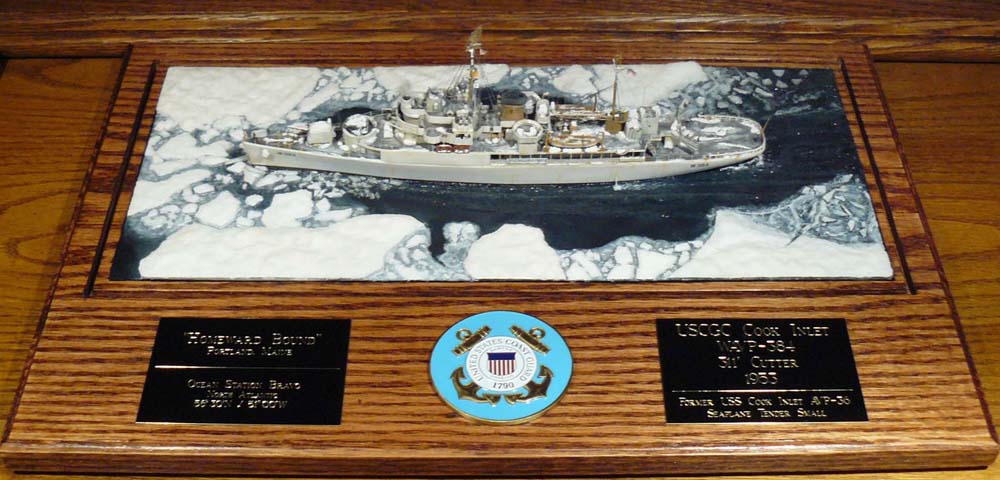
1/350 USCGC Cook Inlet (Back-Aft Models)
|
by Carl Musselman |

1/350 USCGC Cook Inlet (Back-Aft Models)
Formerly the USS Cook Inlet AVP-36 Seaplane Tender Small, here is the USCGC Cook Inlet WAVP-384 in her earliest Coast Guard configuration starting in 1949 when she was loaned to the Coast Guard by the Navy. The Cook Inlet was one of eighteen “311’ Cutters” of the “Casco Class” that served in the Coast Guard; some as late as into the 1970’s. In 1965, these ships were re-designated as High Endurance Cutters (WHEC).
Some of the first, obvious features added for the Coast Guard were the towing rail around the fantail, the boat davits, the balloon shelter and aft catwalks, and supporting oceanographic and meteorological laboratory compartment. During their service, these 311’ Cutters went through many changes in their exterior appearances. These changes included the loss of the crane and its being replaced by a pole mast; the loss of the Twin 40mm Gun Tubs and Gun Director Tower near the Stack; the replacement of the weapons at the #2 station with a Hedgehog launcher or 81mm mortar launchers. Later on, the pole mast was replaced by a tripod mast with a larger balloon shelter and lab compartment. Overall, these changes, and many others, occurred to all of these 311’ Cutters individually and seldom was it found that any two of them looked identical.
My 1/350 scale resin model utilized the 1950’s USCG Conversion Set from Back-Aft Models including the custom USCG waterline hull with the obvious towing rail around the fantail. Other elements of the model, to include some of the photo-etched brass, are from the original USS Mackinac AVP-13 resin kit by Iron Shipwrights, Inc.
The foremast was scratch built as was the king post and top mast of the crane.
Several after-market accessories were used including 5” Turret which is a combination of Corsair Armada and Alliance Modelworks; Quad 40mm and 20mm guns from L’Arsenal; small boats by Iron Shipwrights, Inc.; figures, life rafts, railings and vertical ladders from L’Arsenal; accommodation ladder and crane rigging by Alliance Modelworks; SR Radar by White Ensign Models; gun directors from Yankee Modelworks; anchor chain, flags and custom hull decals by Hawk Graphics; binnacle and pelorus by Paper Lab; 12” signal lights by Veteran Models; 24” search lights by DRAGON; and more railings by Tom’s Modelworks.
I used Refer White by Polly Scale for the vertical surfaces and Model Master Acrylic Gunship Gray for the decks. Non-skid treads on the decks are by DRAGON. Model Master Acrylic International Orange for the life rafts and life rings. LifeColor’s Matte Leather for the davits, stack, mast, crane and other deck equipment.
The rust weathering was achieved by applications of gray and black pastel chalk to tone down the white hull and superstructure. Bright orange pastel chalk and water color pencil. The orange chalk was used sparingly to just discolor the white paint in patchy areas over all, giving the effect of the rust creeping up from under the paint. The orange water color pencil was used to make more prominent areas of rusting on several areas of the hull. Model Master Acrylic Gloss Clear was used before the decals, to seal in the weathering and Model Master Acrylic Flat Clear for the final coat.
The ice flow water base started out with a wave-textured, 1/8” thick, light blue tinted piece of plexiglass that I bought, second hand, in two large 2’ x 4’ sheets from my local trophy shop friend. The water base was airbrushed using acrylic Black, Dark Sea Blue, and a Gray-Green mix and then a coat of Future floor was.
For the ice, I melted down two white candle sticks in a double boiler and poured the wax out flat, and to the desired thickness, into a cookie sheet pan. This flat wax was then broken up into irregular shaped and varying sizes of pieces. With a pattern of the hull’s shape, cut out of painters’ blue tape, attached to the water base, I practiced with the arrangement of the large pieces of ice and when I was satisfied with the look, I glued them to the water using CA glue. The same was done with the medium and small pieces of ice.
The ice pieces were painted using Polly Scale Refer White and then sprinkled with Granulated Alum (which can be found in the spice aisle at the grocery store and which was further ground using the mortar and pestle method) after an application of Elmer’s white glue. The “slushy” areas between the smaller pieces of ice were accomplished using a thin wash of blue-gray and a wash of white.
The ripples on the sides of the ship and the wake behind the ship were done with Liquitex Super Heavy Gel and Gloss Gel. A final glossy coat using Model Master Acrylic Gloss was used over the water between the ice pieces.
The water base was placed into a 1/8" recess that I routered out in the wooden base and the ship was affixed to the base using bolts screwed up into the hull from below. The ship was further affixed by the use of Liquitex Gel applied along the hull where it meets the water. Additional ice pieces were added after the ship was in place. A groove was also routered around the perimeter of the water base to accommodate a plexiglass dust cover case.
The snow aboard the ship was also Granulated Alum and applied using
CA glue. Because some of the glue and the deck color under it was
still visible in places, I painted the snow on the ship with Refer White.
